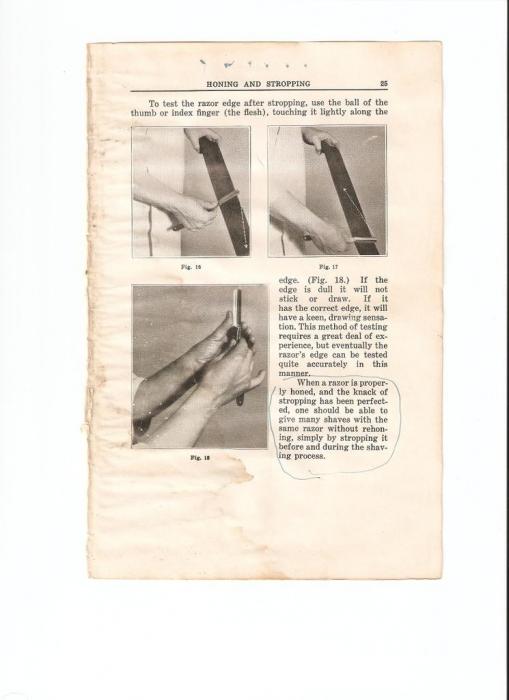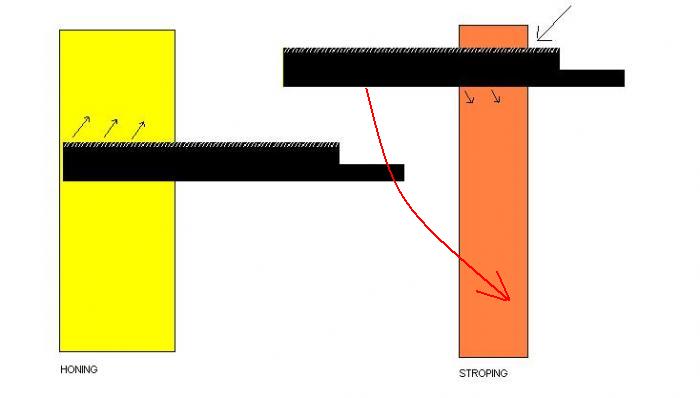Results 11 to 18 of 18
Thread: X-pattern for stropping
-
05-05-2008, 06:07 PM #11Senior Member


- Join Date
- May 2006
- Posts
- 2,516
Thanked: 369
Now, back on topic...

The above photo from an old barber manual (and others very similar) have been posted a few times recently on SRP.
The photo clearly shows the BEGINNING of the classic X pattern stropping stroke. What it fails to show is the actual follow through of the stroke, except for a directional arrow indicating the path of the razor.
Unless you've seen a trained barber stropping, the above photo could be confusing as it could be assumed that the stroke is performed with the razor maintaining a static position, heel leading.
But if you look closely, you will see the directional arrow in the photo begins at the point of the razor. In actual performance, the razor, as it travels diagonally, pivots around the heel, and the point leads through most of the stroke.
A bit hard for me to describe (much easier to show), but I'm hoping you get the idea.
Scott
Scott
-
05-05-2008, 09:08 PM #12Senior Member

- Join Date
- Feb 2008
- Posts
- 766
Thanked: 174
When you hone your razor,using the x pattern,
the scratch pattern on the bevel of the blade is at an angle of say 45 degrees to the vertical and so is the furry edge of the blade, the teeth. If you hold the blade ready to saw through a piece of wood as you would with wood saw the 45degree angle is as you would find the teeth on a saw, ready to rip int the wood. Just like the liittle hairs on the razor are ready to rip into your beard.
If you use an x pattern with the strop which is a natural process with a 2" strop, you are effectively drawing the teeth not with the pile on the leather but against the pile. Logically, you would think this would snap the fairy edge off and blunt the blade. It doesn't.
I also don't understand how or why stropping works. It seems totally illogical.
-
05-05-2008, 09:47 PM #13Member

- Join Date
- Feb 2008
- Location
- FL
- Posts
- 81
Thanked: 1 Thanks!
Thanks!
Thanks to everyone who has replied to my question and to those of you who brought this thread to a level I didn't know existed, I find it very interesting although not quite catching every detail.
-
05-07-2008, 01:53 AM #14

Whether you use an x pattern or not the key is to get the entire edge stropped in a single stroke both back and then again forth. Getting the entire edge lets the alignment of the edge act in a sort of wave.
I use a tad of pressure when I strop, move the blade along the edge smoothly so the entire edge gets stropped in one stroke, flip, then back the other way. The pattern isn't critical, its the continuous motion and the alignment in a single stroke.
The last four strokes are done with absolutely no pressure.
Sometimes when I do this the edge gets too sharp and I almost long for the days when I couldn't strop for s t.
t.
-
05-07-2008, 12:16 PM #15
-
05-07-2008, 01:38 PM #16Senior Member

- Join Date
- Feb 2007
- Location
- Chicagoland
- Posts
- 844
Thanked: 155
The X pattern actually comes naturally on a hanging strop. Typically, you stand to your strong side (e.g. right side if you are right handed) of the strop. In this position, it is very difficult to do anything but an X pattern. At least this is what I have found. I have a 3" strop, so the X pattern is not really necessary to cover the entire blade, but I just dont see how I could do stroke parallel to the strop with out some serious contortions.
-
05-07-2008, 03:01 PM #17
-
05-09-2008, 11:24 PM #18Senior Member


- Join Date
- May 2006
- Posts
- 2,516
Thanked: 369


 LinkBack URL
LinkBack URL About LinkBacks
About LinkBacks






 Reply With Quote
Reply With Quote



